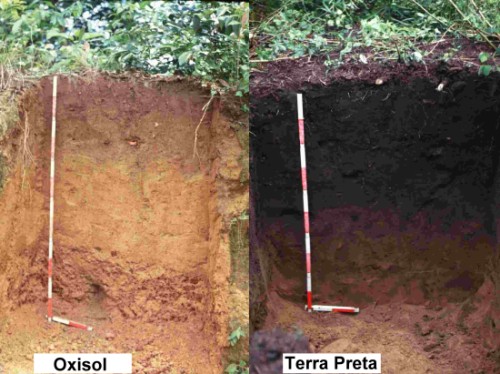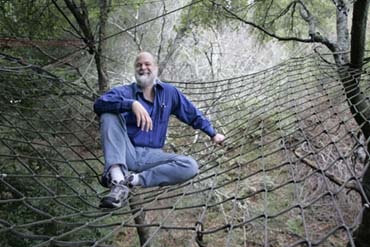Learning From Ancient Gardeners

In the upland areas of the Amazon basin, the soil is acidic and highly weathered, and the constant rain washes nutrients out of the upper soil layers. In the forests, the trees have deep roots to collect nutrients. But in areas used for agriculture, the topsoil cannot retain the soluble nutrients needed to grow corn, beans, or other crops.
However, some 2000 years ago, Amazonian farmers developed a way of building exceptionally rich soils called Terra Preta do Indio, that are remarkably good at retaining phosphorus, potassium, calcium, zinc, and copper, and have been found to be better than surrounding soils, even those with added phosphate fertilizers.
Throughout the Amazon region, large islands of this rich soil can be found, surrounded by the natural nutrient-poor soils of the region, called oxisols.
The secret is charcoal.
Charcoal forms when wood is burned slowly in low oxygen environments, such as when it is buried. The charcoal does not break down as easily as unburned organic matter, and can remain in the soil for centuries. Charcoal is used in charcoal filters because it is very good at trapping many chemicals, such as the phosphorus and potassium that plants need to grow. That same quality helps charcoal keep nutrients in the topsoil from leaching out during heavy rainfall.
The soil also contains calcium and phosphorus from fish bones, and has a lot of organic matter in it, making it an excellent soil for earthworms and termites, which turn the soil and work the nutrients deep into the earth.
The benefits of storing large amounts of carbon in the soil extend beyond making the soils fabulously more productive. By sequestering carbon in stable soils for centuries, we can reduce the amount of carbon dioxide in the atmosphere, and reduce global warming.

1 Comments:
I feel we should push for this Terra Preta Soils CO2 sequestration strategy and only go for weather modification if we fall over any of the serious tipping points.
The economics look good, and truly great if we had CO2 cap & trade in place:
There are processes that you can have your Bio-fuel and fertility too.
'Terra Preta' soils I feel has great possibilities to revolutionize sustainable agriculture into a major CO2 sequestration strategy.
I thought, I first read about these soils in " Botany of Desire " or "Guns,Germs,&Steel" but I could not find reference to them. I finely found the reference in "1491", but I did not realize their potential .
Current issue of Nature article: http://www.nature.com/nature/journal/v442/n7103/full/442624a.html
Here's the Cornell page for an over view: http://www.css.cornell.edu/faculty/lehmann/biochar/Biochar_home.htm
This Science Forum thread on thes soil contains further links: http://forums.hypography.com/earth-science.html
The Georgia Inst. of Technology page:
http://www.energy.gatech.edu/presentations/dday.pdf
There is an ecology going on in these soils that is not completely understood, and if replicated and applied at scale would have multiple benefits for farmers and environmentalist.
Terra Preta creates a terrestrial carbon reef at a microscopic level. These nanoscale structures provide safe haven to the microbes and fungus that facilitate fertile soil creation, while sequestering carbon for many hundred if not thousands of years. The combination of these two forms of sequestration would also increase the growth rate and natural sequestration effort of growing plants.
Also, Terra Preta was on the Agenda at this years world Soil Science Conference !
http://crops.confex.com/crops/wc2006/te ... P16274.HTM
I've sent this thread to the researchers at M-Roots, who make Mycorisal fungus inoculations for acceleration of the reestablishment of the symbiotic fungal / root relationship. Here's the M-Roots site: http://www.rootsinc.com/
I also sent it to Dr. Jared Diamond, if he replies, I will probably have an orgasm!
Here is a great article that high lights this pyrolysis process , ( http://www.eprida.com/hydro/ ) which could use existing infrastructure to provide Charcoal sustainable Agriculture , Syn-Fuels, and a variation of this process would also work as well for H2 , Charcoal-Fertilizer, while sequestering CO2 from Coal fired plants to build soils at large scales , be sure to read the "See an initial analysis NEW" link of this technology to clean up Coal fired power plants.
Soil erosion, energy scarcity, excess greenhouse gas all answered through regenerative carbon management http://www.newfarm.org/columns/research ... coal.shtml
If pre Columbian Indians could produce these soils up to 6 feet deep over 20% of the Amazon basin it seems that our energy and agricultural industries could also product them at scale.
Harnessing the work of this vast number of microbes and fungi changes the whole equation of EROEI for food and Bio fuels. I see this as the only sustainable agricultural strategy if we no longer have cheap fossil fuels for fertilizer.
I would like to investigate if use of an M-Roots type fungus inoculant and local compost would speed this super community of wee beasties in populating into their proper Soil horizon Carbon Condos.
I feel Terra Preta soil technology is the greatest of Ironies since Tobacco.
That is: an invention of pre-Columbian American culture, destroyed by western disease, may well be the savior of industrial western society. As inversely Tobacco, over time has gotten back at same society by killing more of us than the entire pre-Columbian population.
Erich
Erich J. Knight
Shenandoah Gardens
E-mail: shengar@aol.com
(540) 289-9750
Post a Comment
Links to this post:
Create a Link
<< Home